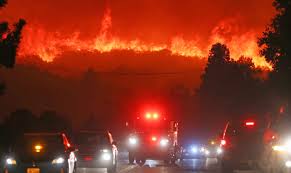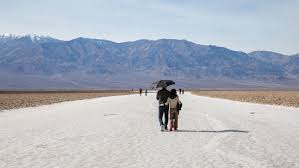Death Valley National Park Fascinating Facts-1913
Death Valley National Park Fascinating Facts
In this section, we explore a few Death Valley National Park Fascinating Facts about this unique desert habitat. The Death Valley National Park is a location of bleak beauty, harsh weather, and amazing natural treasures. It is situated where California and Nevada meet.
It is a place of superlatives, and because of its peculiar features, it is one of the most mysterious and enthralling national parks in the United States. In this section, we explore further into a few fascinating details about this unique desert habitat.

Follow Our Digiknowledge.co.in Page for Latest update about Bikes, Cars, Sports, , Life style and many more.
- Death Valley National Park Fascinating Facts -1– Death Valley holds the record for the planet’s hottest air temperature that has been consistently measured. The highest natural air temperature ever recorded was in Furnace Creek, where it scorched to a blistering 134 degrees Fahrenheit (56.7 degrees Celsius) in 1913. Death Valley has some of the world’s hottest summers, making it a genuine desert furnace.
- Death Valley National Park Fascinating Facts-2 -There record of lowest point in North America is hold in Death Valley, where Bad water Basin is famous for the title of lowest point in the whole Western Hemisphere. Its mesmerizing hexagonal salt polygons extend for miles on this salt flat, which is 282 feet (86 below sea level. This is the contrast exists between the salt plains and the imposing Panamint Mountains.
- Death Valley National Park Fascinating Facts -3– A wide variety of geology can be found in the park. It is a geological display, with a variety of formations, ranging from the soaring peaks of the Panamint Range to vibrant gorges like Golden Canyon and Mosaic Canyon. A further intriguing geological feature is the enormous volcanic crater known as Ubehebe Crater.

- Death Valley National Park Fascinating Facts -4 – Fans of the Star: Wars franchise would be pleased to learn that Death Valley’s Mesquite Flat Sand Dunes were used as a filming location for “Star Wars Episode IV: A New Hope.” These recognizable dunes were used in the Tatooine desert planet scenes and are now a well-liked tourist destination for both nature and film buffs.
- Death Valley National Park Fascinating Facts -5- Vulnerable species:– Death Valley is home to a variety of rare and hardy species despite its harsh surroundings. The Devil’s Hole Pupfish stands out among them all. One of the rarest fish species in the entire world, this little fish is only found in a solitary, isolated pool in the park. It is a severely endangered species that has evolved to thrive in the harsh environment of the park, with fewer than 100 individuals remaining in the wild.
- Death Valley National Park Fascinating Facts –6- Borax Mining Tradition : Borax, a mineral used in many products, including cleaning chemicals, was formerly a major source in Death Valley. Borax had to be transported hundreds of miles through some of the worst terrain by the renowned 20-Mule Teams from Death Valley to the closest railhead. This history demonstrates the tenacity and tenacity of the early settlers in the area.
- Death Valley National Park Fascinating Facts -7– Celestial Nightscapes: Death Valley National Park has been classified as an International Dark Sky Park, making it a paradise for astronomers. Observing the night sky there is made possible by its isolation and lack of light pollution. There is full visibility of the Milky Way, planets, and numerous stars. The most common equipment used to see the sky here is a telescope or pair of binoculars.
- Death Valley National Park Fascinating Facts – 8 Occasional super blooms, which happen as a result of rain, can cause Death Valley’s seemingly dead landscape to burst into vivid coolers. A fantastical and breathtaking sight results when these super blooms turn the desert into a carpet of wildflowers. Botanists and outdoor enthusiasts swarm the park to see this extraordinary display.
- Death Valley National Park Fascinating Facts-9 Large rocks in the distant region known as the Racecourse Playa leave perplexing paths as they wander across the dry lakebed. For decades, scientists have been perplexed by these enigmatic moving pebbles. Even though this phenomenon’s precise mechanism has been researched, it is still a fascinating mystery. According to theories, the rocks’ motions are caused by a combination of ice, wind, and water.

- Death Valley National Park Fascinating Facts – 10 Geological Time Warp : Valley presents a special chance to investigate Earth’s geological past. The park has rocks that date back more than a billion years, and the surrounding terrain depicts the evolution of the planet. The Panamint Range and the Black Mountains are examples of ancient rock formations that offer a window into Earth’s geologic past.
A trip to Death Valley National Park is a journey into a surreal world where the forces of nature have shaped a place of extremes. Adventurers, scientists, and lovers of nature are drawn to the park because of its unusual geology, harsh temperature, and strange life types.
It’s a location where you can see the amazing tenacity of life in one of the world’s toughest conditions while also contemplating the mysticism of the shifting rocks and the geological marvels of this amazing desert landscape. Death Valley is not just a national treasure; it is also a remarkable illustration of the evolution of the planet’s geology and the might of nature.
What is Death Valley National Park famous for?
Death Valley National Park. Death Valley, known as the driest place in North America and the location with the highest temperature ever recorded anywhere in the world (a scorching 134 degrees in July 1936), is enticing to explore from autumn into spring.
What are the dangers in Death Valley?
Floods: When it rains, stay away from canyons, and be ready to move to higher ground. Watch out for water flowing across road dips and across washes as you drive. Mine Risks: Avoid going into mine shafts or tunnels. Mines could be unstable, have secret shafts, have terrible air pockets, and be poisonous.
What are the rare animals in Death Valley?
The Devils Hole pupfish is a very uncommon and endangered species of pupfish that is exclusive to the Devils Hole aquatic habitat. Death Valley National Park is a separate area that includes this deep, geothermal spring-fed pool.
How many plants are in Death Valley?
More than 1,000 plant species have been described for Death Valley, including everything from old bristlecone pines to fleeting spring wildflowers.
How many species live in Death Valley?
Over 400 animal species and 1,000 different plant species can be found in Death Valley, which is perhaps best recognized for its desolate scenery.
Why is Death Valley the most dangerous place on Earth?
One of the hottest spots in the world, according to legend. It’s hotter than any time in history has been observed.



